BBC Radio 1 and 102.3 NOW! Radio in Canada both use social deejays and Facebook marketing to build listener communities. How social focus results in high ratings.
“Who has the most Twitter followers in the building, do you think?” BBC Radio 1 presenter Scott Mills is joking with this rhetorical question. With 530.000 Twitter followers and 408.000 Facebook friends he’s a well-selected host for this Radio Festival session about how radio can use social media to connect to listeners.
“To establish a successful station in a competitive market, you need a lot of fans”
1. Show case: Scott Mills
Scott Mills is somewhat surprised about his online success. Because what he writes about is “literally just stuff that I do every day”. Social media have become a huge part of his drive time slot. “First calling in was important; then texting in was important. Now, social media run the show.” Online communities are a big part of his drive time show on BBC Radio 1. The idea is to engage listeners through interactive stunts.
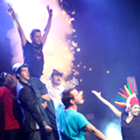 Creating social media events
Creating social media events
Scott Mills The Musical (photo) was a performance in which the audience participated through Twitter and Facebook. BBC Radio 1 listeners could decide who should be on the cast, and what songs they wanted to hear. An older idea was ScottCam: a Big Brother event, in a time when Facebook and Twitter were not that big yet. Mills was filmed in his home for a whole week (“which was horrendous”). Half a million people followed him 24/7.
Trending worldwide on Twitter
Mills also sees the effect of celebrity guests, like X-factor band One Direction: “Every time you have them on, you’ll be worldwide trending on Twitter within two minutes.” He adds that even simple content can have a huge impact on the audience: “Last week I’ve had an accident while blending soup. Within 15 minutes of posting a picture we had 841 likes and over 500 comments on Facebook. And that was just a picture that I took in my kitchen.”
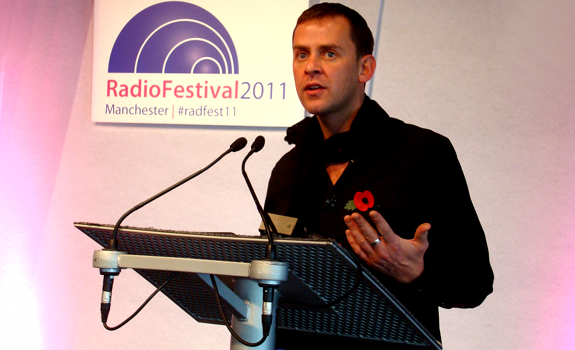
Scott Mills, BBC Radio 1 drive time jock, talks about how social media boost radio shows (photo: Thomas Giger)
2. Station case: NOW! Radio
Besides radio personalities and shows, stations benefit from social media, too. Ken Benson of P1 Research shares the remarkable case of 102.3 NOW! Radio in Edmonton, Canada. First, a few numbers:
- 6th radio market in Canada
- 18 other radio stations in the market
- 1.200.000 potential listeners in the market
- 81.000.000 dollars advertising budget in the market per year
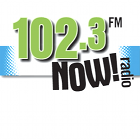 Conquering market share & revenue
Conquering market share & revenue
“The ratings continue to grow, but the revenue has been absolutely astounding. They take nearly 20 percent of the dollars in the market right now in 18 months time. To establish a successful station in a competitive market, you need a lot of fans”, the radio researcher says. Becoming Top 5 in the highly sought-after 25-54 demographic was the initial goal. They probably didn’t know before how soon they would reach (and top) this target.
Accelerating radio ratings growth
After the launch in February 2010, NOW! Radio “took off like a rocket”, says Benson. He shows numbers that are similar to Z100, going ‘from worst to first’ in 1983:
- after 30 days – number 8
- after 60 days – Top 5 in 25-54 years
- after 90 days – number 1 in 25-54 years
Here’s a part of the sign-on imaging promo of NOW! Radio:
[audio:http://www.radioiloveit.com/wp-content/uploads/102-3-now-radio-canada-sign-on-imaging-promo-radio-festival-manchester-2011-recording-thomas-giger.mp3|titles=102-3-now-radio-canada-sign-on-imaging-promo-radio-festival-manchester-2011-recording-thomas-giger]
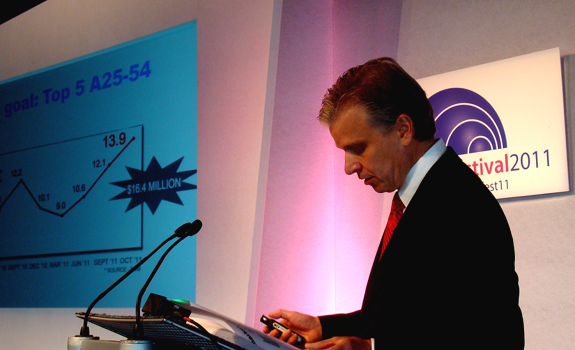
Ken Benson of P1 research shows 102.3 NOW! Radio’s advertising revenue development (photo: Thomas Giger)
Programming broad, focusing social
In a radio market of 18 established brands, finding a unique and still profitable music format was impossible. Ken Benson recalls that “every obvious music opportunity that could put us in the Top 5 was already taken”. Therefore it was decided to combine a mass-appeal music format with focused social media activities. The music became Hot AC, based on 80s, 90s and 2000s. “We didn’t position it at all; we never had a music claim. It’s the social interaction that drives the radio station.”
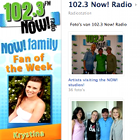 Inviting audience: co-create content
Inviting audience: co-create content
In a video message, veteran radio consultant George Burns describes 102.3 NOW! Radio as “a true social media phenomenon. They don’t just use social media to spew out programming, promotions and contests.” He explains that the listener and the radio station co-create the content. “Radio listeners to NOW! have told us that they see themselves as partners in the structuring of each broadcast day.”
Attracting heavy listener group
Burns sees NOW! Radio as a social media radio station hybrid. “It turns the daily social media experience into a radio experience through the help of their hosts. Social deejays, as we call them.” He speaks of a new radio relationship and unique gender balance. Women like the friendly conversation and music mix, while men see the music more as background (“artists like Lady GaGa and Katy Perry are not big guy magnets”). Male listeners perceive NOW! Radio as a modern talk station with a pop music soundtrack.
“The success has been nothing short but extraordinary”
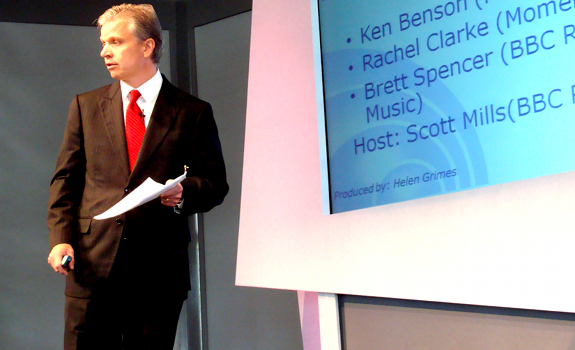
Ken Benson attributes NOW! Radio’s success to their constant, creative audience interaction (photo: Thomas Giger)
Responding to audience interaction
NOW! Radio answers every single message, even at the current average of 5.000 messages per day. Everyone on the staff is answering messages, from receptionists to sales people, from interns to radio personalities. “They don’t use auto replies; they personally respond to every single one. In fact, after less than 18 months we hit 1 million incoming messages”, says Ken Benson of P1 Research. “It’s the key point of differentiation and it really has come back in research that it’s appreciated.”
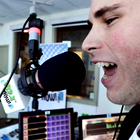 Including fresh programming elements
Including fresh programming elements
“The whole station is very spontaneous and unpredictable. If they want to do a 6-minute talk break, they can. There’s no specific place to jingle or sweep, they play ads wherever they want.” Benson adds that the station has no deejays in the traditional sense. “We deliberately avoid traditional radio names, and treat them as social media hosts.” He quotes George Burns who said in the video that “they are the glue that holds the radio station together.”
Building social radio foundation
NOW! Radio has its roots in the local community in different ways. Many of their events are easy and low-cost to produce, and still engage a lot of people with the radio station:
- Social media interaction: a day or two before their show, presenters post topics on Facebook, watch what happens, and often use it as showprep and on-air content
- Charity prizes: the radio station started the NOW! Family where people help one another – if they win a $ 1.000 prize, they also win $ 1.000 to give away to a charity
- Public events: in the Summer on a Sunday afternoon, listeners are invited to come walk their dog in a local park, which sometimes attracts “thousands” of people
- On-air fun: every shift, the deejay has $ 100 to give away to anyone they want, from the person that sends the most original text to the first to come down to the studio with a free pizza
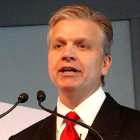 Having station promotions ‘communicate’
Having station promotions ‘communicate’
The station’s outdoor advertising includes the community feeling as well. Ken Benson (photo) mentions a billboard campaign around avatars, like we know them from Facebook profiles. The billboards just showed a few presenters, the other faces were listeners who’d submitted their photos to be on them. “When they went up, everyone was looking for their picture and to see who they could identify.” It created a lot of talk on the station’s Facebook page.
Establishing social radio network
Benson explains that NOW! Radio’s positioning is based on today’s popularity of online communities. “Edmonton’s Social Network is something that came out of our listener groups – that’s how they refer to the radio station.” He says that it was a lot of fun to work on this project. “It all started with a station owner that was committed to try something new, take some risk and write a new playbook that’s changed a lot since we first signed on 18 months ago. The success has been nothing short but extraordinary.”
Read also:
- Programming (related articles)
Stay tuned, follow us: @RadioILOVEIT





Add Your Comment